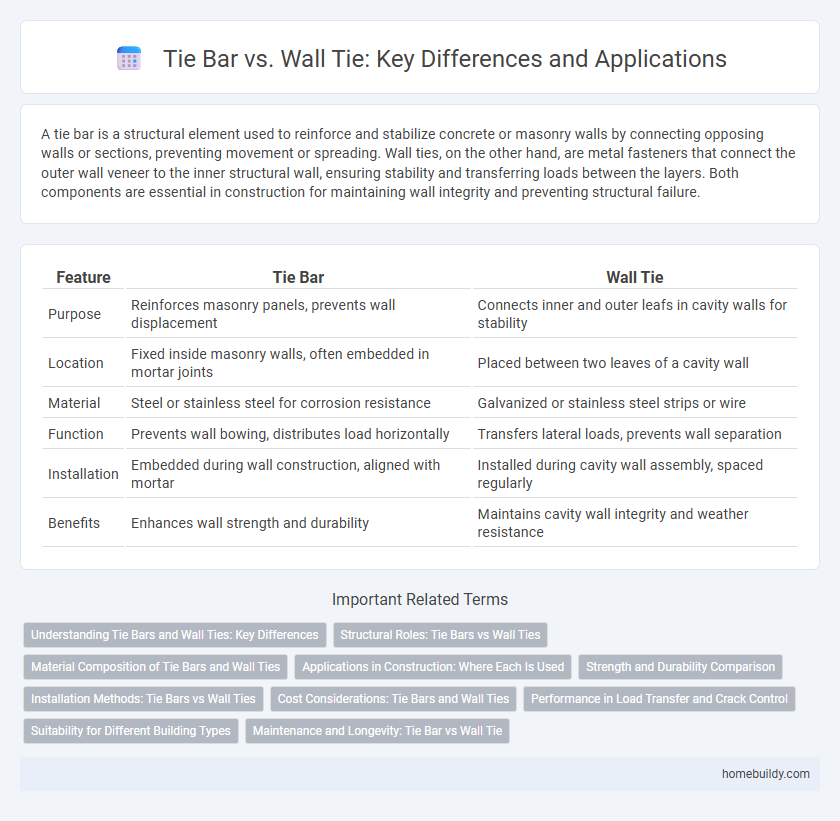A tie bar is a structural element used to reinforce and stabilize concrete or masonry walls by connecting opposing walls or sections, preventing movement or spreading. Wall ties, on the other hand, are metal fasteners that connect the outer wall veneer to the inner structural wall, ensuring stability and transferring loads between the layers. Both components are essential in construction for maintaining wall integrity and preventing structural failure.
Table of Comparison
| Feature | Tie Bar | Wall Tie |
|---|---|---|
| Purpose | Reinforces masonry panels, prevents wall displacement | Connects inner and outer leafs in cavity walls for stability |
| Location | Fixed inside masonry walls, often embedded in mortar joints | Placed between two leaves of a cavity wall |
| Material | Steel or stainless steel for corrosion resistance | Galvanized or stainless steel strips or wire |
| Function | Prevents wall bowing, distributes load horizontally | Transfers lateral loads, prevents wall separation |
| Installation | Embedded during wall construction, aligned with mortar | Installed during cavity wall assembly, spaced regularly |
| Benefits | Enhances wall strength and durability | Maintains cavity wall integrity and weather resistance |
Understanding Tie Bars and Wall Ties: Key Differences
Tie bars are horizontal steel reinforcements embedded in masonry walls to enhance structural stability, whereas wall ties connect two separate masonry wythes, ensuring the transfer of loads and preventing separation. Tie bars primarily provide tensile strength against lateral forces, while wall ties maintain the integrity of cavity walls by linking inner and outer layers. Understanding these distinctions is crucial for selecting appropriate reinforcement in construction projects involving masonry wall systems.
Structural Roles: Tie Bars vs Wall Ties
Tie bars function primarily as tension elements that connect reinforcing bars across concrete joints, ensuring structural continuity and load transfer in concrete slabs and beams. Wall ties serve to anchor masonry walls to structural frames, providing lateral stability and preventing separation under wind or seismic forces. Both components are crucial in maintaining structural integrity but differ in application; tie bars reinforce internal concrete connections, while wall ties secure external masonry walls to the main structure.
Material Composition of Tie Bars and Wall Ties
Tie bars are typically made from steel or stainless steel, providing high tensile strength for structural reinforcement. Wall ties, commonly constructed from galvanized steel or stainless steel, offer corrosion resistance essential for connecting masonry walls to the structural frame. The material composition of tie bars emphasizes load-bearing capacity, while wall ties prioritize durability and resistance in varying environmental conditions.
Applications in Construction: Where Each Is Used
Tie bars are primarily used in concrete construction to hold wall panels or forms together during pouring, ensuring structural alignment and stability without penetrating the finished surface. Wall ties are commonly implemented in masonry cavity walls to connect the inner and outer wall leaves, providing lateral support and preventing wall separation. Tie bars suit temporary formwork applications, while wall ties are essential for permanent bonding in masonry structures.
Strength and Durability Comparison
Tie bars and wall ties differ significantly in strength and durability, with tie bars typically offering higher tensile strength due to their solid steel construction. Wall ties, often made from galvanized or stainless steel strips, provide sufficient durability for masonry anchoring but may be more susceptible to corrosion over time compared to sturdier tie bars. In construction applications requiring maximum load-bearing capacity and long-term stability, tie bars generally outperform wall ties in both strength and durability metrics.
Installation Methods: Tie Bars vs Wall Ties
Tie bars are installed by embedding them into masonry joints and securing both adjacent walls for structural reinforcement, typically requiring precise alignment and anchoring with mechanical or chemical fixings. Wall ties are inserted during wall construction or retrofitted by drilling into the mortar joints and often fixed using resin or mortar, providing lateral support between cavity walls. Both methods demand proper spacing and depth to ensure effective load transfer and prevent moisture penetration or corrosion.
Cost Considerations: Tie Bars and Wall Ties
Tie bars generally offer a higher upfront cost compared to traditional wall ties due to their robust materials and installation requirements. Wall ties are more cost-effective for standard masonry reinforcement, making them ideal for budget-sensitive projects. Evaluating long-term structural benefits and maintenance expenses helps determine the most economical choice between tie bars and wall ties.
Performance in Load Transfer and Crack Control
Tie bars provide superior load transfer capacity in concrete structures by directly connecting adjacent elements, ensuring uniform stress distribution and minimizing differential movement. Wall ties primarily serve to anchor masonry walls to structural frames but exhibit limited load transfer efficiency compared to tie bars, which are engineered to resist tensile forces effectively. In crack control, tie bars help reduce crack width and propagation by maintaining alignment and restraining concrete deformation, thereby enhancing structural durability.
Suitability for Different Building Types
Tie bars are primarily designed for fastening and reinforcing masonry walls in residential buildings, providing high tensile strength ideal for lightweight structures. Wall ties, in contrast, are more suitable for cavity wall construction commonly found in commercial and multi-storey buildings, ensuring stability by anchoring external and internal walls together. Selecting between tie bars and wall ties depends on wall construction type and building load requirements, optimizing performance and structural integrity.
Maintenance and Longevity: Tie Bar vs Wall Tie
Tie bars, typically made from durable metals like stainless steel or galvanized steel, require minimal maintenance due to their corrosion-resistant properties and robust design, ensuring long-term structural support in masonry walls. Wall ties, often embedded within mortar joints, are more susceptible to corrosion from moisture exposure, which can compromise their integrity and necessitate periodic inspections and maintenance. Proper selection and installation of tie bars can enhance longevity and reduce upkeep costs compared to traditional wall ties, making them a preferred choice for sustainable building reinforcement.
Tie bar vs Wall tie Infographic

 homebuildy.com
homebuildy.com